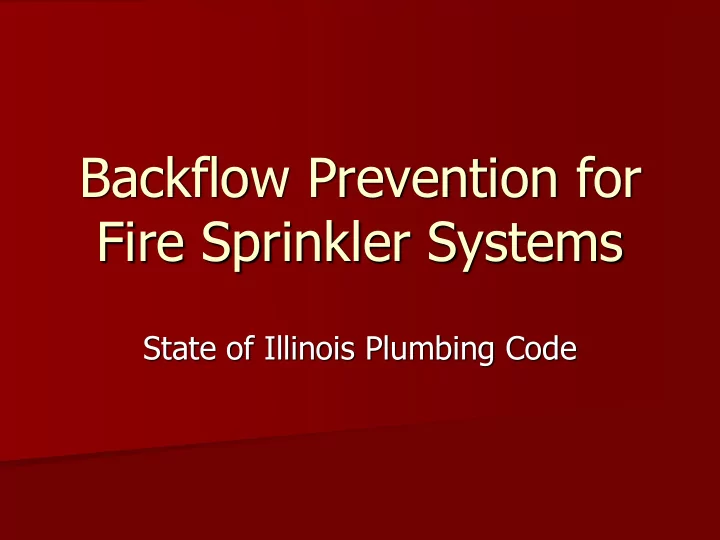

Backflow Prevention for Fire Sprinkler Systems State of Illinois Plumbing Code
Backflow Prevention Fire safety systems connected to a public water supply will require a backflow prevention device between the fire safety system and the public water supply.
Types of Valves Check Double Check Reduced Pressure
Check Valve A valve which permits flow in one direction, from the supply to the end use.
State of Illinois Plumbing Code The State of Illinois requires a DDC (Double Detector Check) valve on all fire protection systems.
Double Check Valve Assembly-DDC or DCVA This assembly consists of two internally loaded check valves, either spring or internally loaded, weighted, installed as a unit between two tightly closing resilient- seated shutoff valves as an assembly, and fittings with properly located resilient seated test ports or cocks.
Diagram
Reduce Pressure Zone (RPZ) or Reduced Pressure Backflow Assembly (RPBA) Two independently acting check valves together with a hydraulically operating, mechanically independent pressure differential relief valve located between the check valves and below the first check valve. These units are located between two tightly closed resilient seated shutoff valves, as an assembly, and are equipped with properly located resilient seated test cocks.
State of Illinois Plumbing Code The State of Illinois requires an RPZ/RPBA valve on all fire protection systems when the following conditions exist.
If the system contains anti-freeze or other chemicals, then an RPZ device is required. If water can be pumped from a non- potable water supply such as a retention pond or lake then an RPZ is required If there is a permanent or emergency connection whereby water can be pumped into the fire safety system-RPZ
Location of the DDC or RPZ Normally the DDC or RPZ is located on the incoming water supply before connection to the fire system If there is a Fire Pump, the RPZ or DDC should be located on the discharge side of the pump
Graph’s: compliments of FSI
Retrofitting DDC’s or RPZ’s The devices will add from 4 -15 psi on the average to the fire protection system hydraulic calculation demand. Most sprinkler systems are hydraulically calculated to within 5 psi of the available water supply.
Who Can Test or Repair an RPZ or DDC A licensed plumber who is also a certified cross control detector inspector.
Diagram
NFPA 25- Backflow Preventors Section 9-6 Maintenance – Conducted by trained individual following manufacturer’s instructions Certified Cross Control Detector Inspector (CCCDI). – Rubber parts replaced in accordance with frequency required by authority having jurisdiction and manufacturer’s instructions
NFPA 25- Backflow Preventors Section 9-6 Inspection – Weekly for valves supervised with seals – Monthly for other supervision methods – Verify: in normal open position – All RPZ devices must be inspected weekly to determine that the relief port is not discharging
1998 NFPA 25 7-3.8 Other Devices Other devices, such as check valves, detector check, and backflow preventors that are installed on the fire sprinkler system shall be inspected and maintained so that they do not impede the flow of water and fire main pressure.
9-6.2 Testing, Backflow 9-6.2.1 All backflow preventors shall be tested annually – A) A forward flow test shall be conducted at the system demand – B) A backflow certification test, as required by the authority having jurisdiction shall be conducted at the completion of the forward flow test.
Sample of Backflow Test form
NFPA 25- Control Valves Section 9-3 Annual Test – Forward flow test at system demand ▪ Exceptions to Forward Flow Test – When connections for system demand are not available, run test at maximum flow – For 2 inch or smaller valves, run test without measuring flow – Where water rationing is in effect for more than 1 year, internal inspection can substitute for flow – Flow Test not required where pump testing causes demand flow through backflow device – Backflow certification test (after flow test)
Forward Flow Test NFPA 13 1999 10-2.6 The backflow prevention assembly shall be forward flow tested to ensure proper operation. The minimum flow rate shall be the system demand, including hose stream where applicable. This is a requirement also called out in NFPA 25 1998 Edition
Underground Piping Tests HYDROSTATIC TEST 200 PSI FOR 2 HOURS From the street line non-indicating valve to the first supply side valve in the protected building.
Underground Flush Test This test is to be conducted before the underground pipe is connected to the fire sprinkler system. Flow the required rate of water listed by the AWWA until the water is clear and there is no collection of material in a burlap bag which is to be placed on the end of the pipe. Flow rates shown on the next slide…
Sprinkler Pipe Tests Flow rates: – 390 gpm for a 4” line – 880 gpm for a 6” line – 1,560 gpm for a 8” line – 2,440 gpm for a 10” line – 3,520 gpm for a 12” line
Why is this Important?
To remove any sand, grit, or debris from underground that may disturb valves or obstruct fire sprinkler head water flow
To insure that the PROPER water supply is available as it was designed
Recommend
More recommend